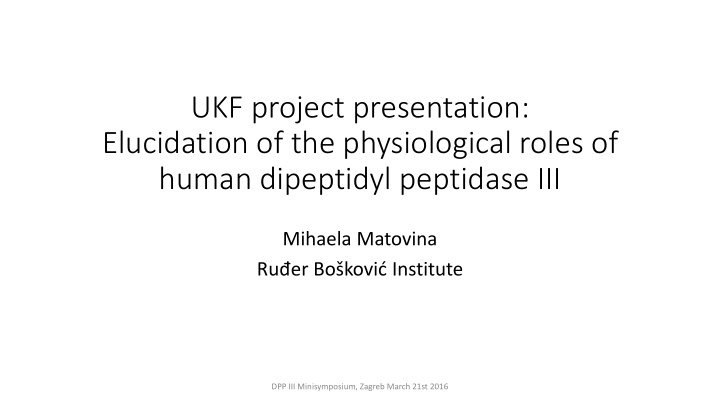



UKF project presentation: Elucidation of the physiological roles of human dipeptidyl peptidase III Mihaela Matovina Ruđer Bošković Institute DPP III Minisymposium, Zagreb March 21st 2016
• UKF – Unity through knowledge fund - 1B Crossing Borders Grant • Croatian Ministry of Science, Education and Sports funding aimed at developing cooperation between scientists in Croatia and Croatian scientists abroad • Funding: 1,409,411.00 kn (around 180,000 euro) • Duration: December 15 2015 to December 14 2017 • Project leader: Koraljka Husnjak, Institute of Biochemistry II, Goethe University School of Medicine, Frakfurt, Germany • Project co- leader: Mihaela Matovina, Ruđer Bošković Institute, Zagreb • Co- workers: Marija Abramić, Marija Kozlović, Sandra Sobočanec, Zrinka Karačić, postdoc (to be hired), Ruđer Bošković Institute, Zagreb DPP III Minisymposium, Zagreb March 21st 2016
• Koraljka Husnjak, Group leader • Ubiquitin Signaling Group • Selected publications : • Aguileta MA, Korac J, Durcan TM, Trempe JF, Haber M, Gehring K, Elsasser S, Waidmann O, Fon EA, Husnjak K**. The E3 Ubiquitin ligase parkin is recruited to the 26S proteasome via the proteasomal ubiquitin receptor Rpn13. J Biol Chem 2015; 290: 7492-505 (**corresponding author) • Ubiquitin-binding proteins: decoders of ubiquitin-mediated cellular functions. Husnjak K, Dikic I. Annu Rev Biochem 2012; 81: 291-322. • Grabbe C, Husnjak K, Dikic I. The spatial and temporal organization of ubiquitin networks. Nat Rev Mol Cell Biol 2011, 12: 295-307. • Husnjak K*, Elsasser S*, Zhang N*, Chen X, Randles L, Shi Y, Hofmann KWalters K, Finley D, Dikic I (2008) Proteasome subunit Rpn13 is a novel ubiquitin receptor. Nature 2008; 453 (7194): 481-488 (*equally contributing). • Schreiner P*, Chen X*, Husnjak K*, Randles L, Zhang N, Elsasser S, Finley D, Dikic I, Walters K, Groll M. Ubiquitin docking at the proteasome via a novel PH domain interaction. Nature 2008; 453 (7194): 548-552 (*equally contributing). DPP III Minisymposium, Zagreb March 21st 2016
Project summary • High-throughput methods to determine DPP III interactome • Yeast-two-hybrid to determine direct interactors • DPP III as bait; normalized human cDNA library as prey DPP III Minisymposium, Zagreb March 21st 2016
• SILAC-MS to determine DPP III protein complexes • Stable transfection of pcDNA4.HA-hDPP3, pcDNA4.HA-hDPP3-E451A, and control pcDNA4.HA in inducible eukaryotic cell lines – grown on heavy, medium, and light media, respectively • lysates merged in 1:1:1 ratio • HA affinity purification • eluates resolved on SDS-PAGE • MS analysis → MaxQuant software • FDR < 1 % • hits that are identified by the presence of at least two unique peptides • hits highly enriched (at least 2-fold) in DPP III interactome in comparison to empty plasmid control • datasets will be functionally analyzed by KEGG PATHWAY – to determinethe processes and pathways enriched in the obtained interactome DPP III Minisymposium, Zagreb March 21st 2016
• Choose putative 5 interactors to do a more specific analysis – selection based on: • Y2H hits that were also deterimed as top MS-based interactome components • Hits that have been found in multiple copies in the Y2H screen • Proteins which participate in processes that have already been linked with DPP III functions • Proteins which participate predominantly in processes/pathway for which we have expertise as laboratories DPP III Minisymposium, Zagreb March 21st 2016
• Low-throughput analysis of the selected putative interactors: • His and GST pulldowns from bacterial lysates • Co-immunoprecipitation from eukaryotic cell lysates • Colocalization and FRET analysis of DPP III and putative interactor by confocal microscopy • ITC studies with purified proteins DPP III Minisymposium, Zagreb March 21st 2016
DPP III Minisymposium, Zagreb March 21st 2016
Recommend
More recommend